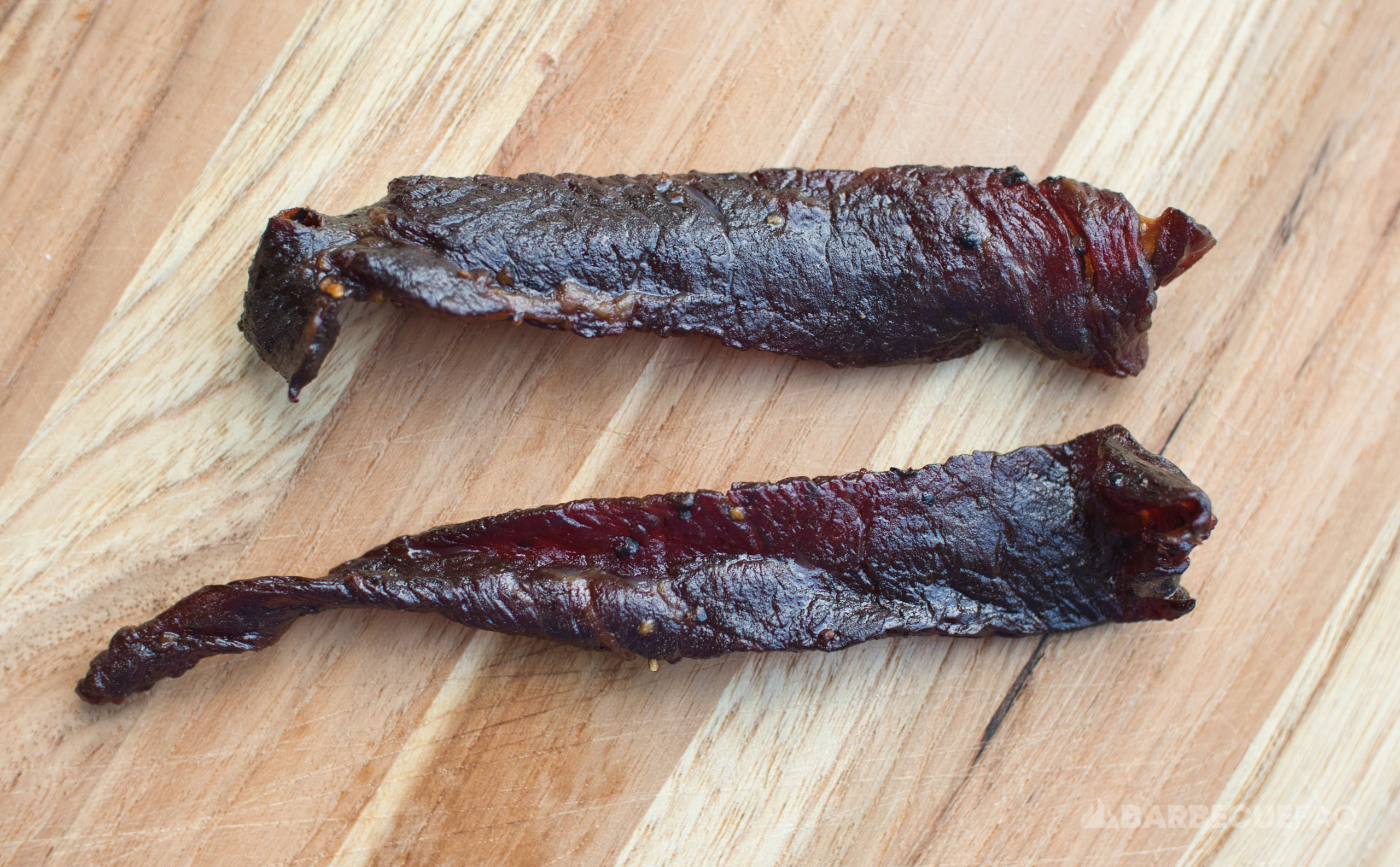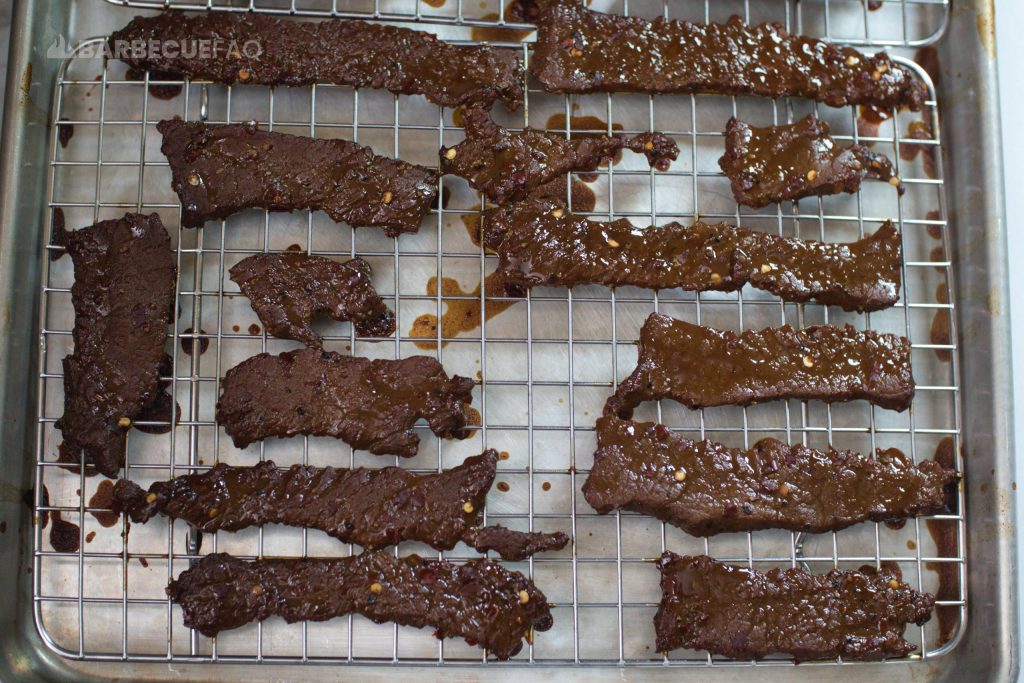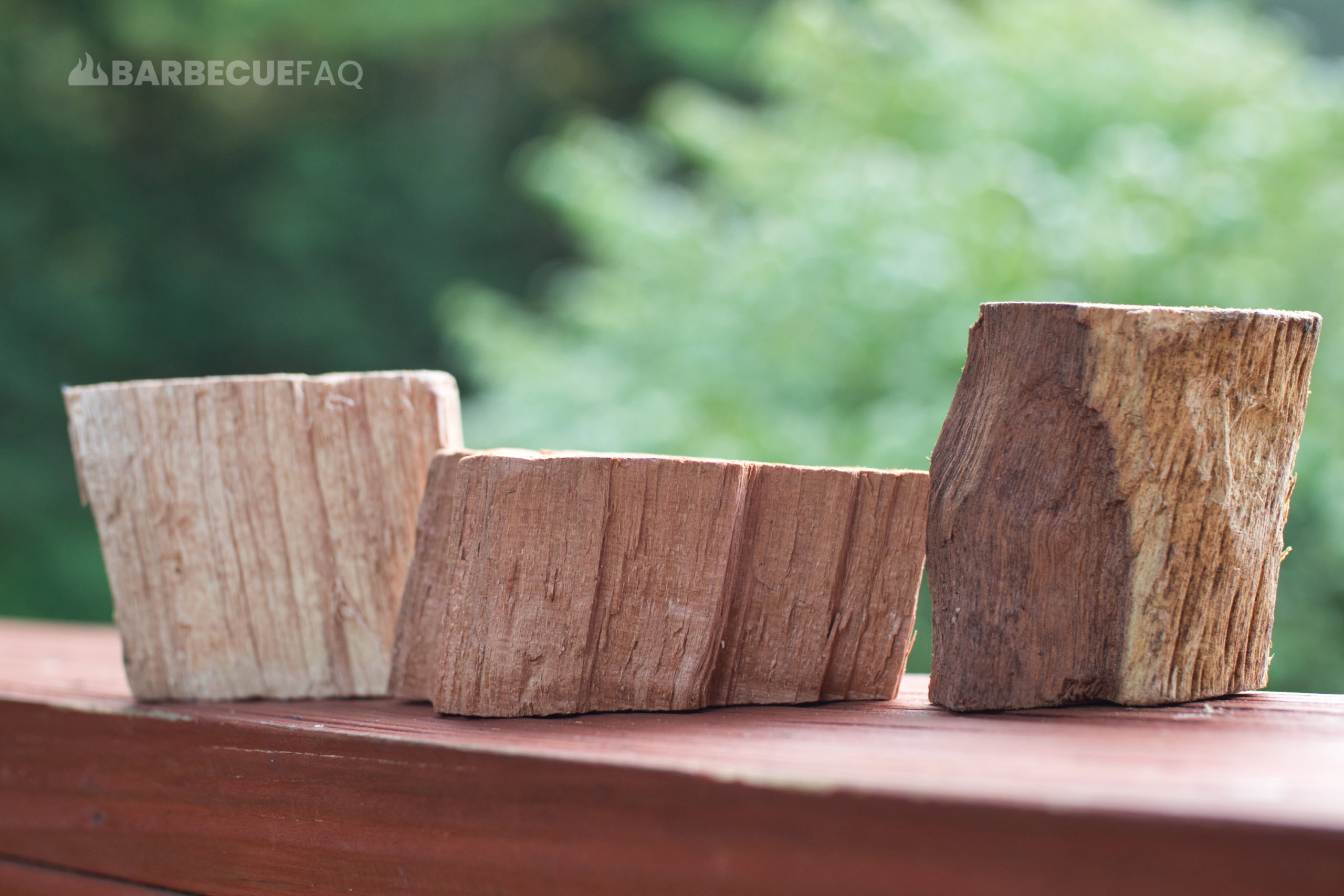| Description | Dehydrated | Smoked |
|---|---|---|
| Flavor | Only way to get smokey flavor is via liquid smoke | Has a smokey flavor from real hardwood |
| Marinade | More flavors | Typically monotone, like teriyaki |
| Texture | Dry – can be soft depending on marinade | Has a pellicle (skin) from wood smoke |
There’s also the topic of shelf-life, which you can jump to here.
Taste Differences
In terms of texture, due to the compounds of the hardwood smoke, the exterior of the meat will develop a distinct pellicle (or “skin”).
It also has the benefit of improving color which is appealing.

This is the same thing that occurs with smoked meats like brisket, forming a “bark” on the outside of the meat.
With dehydrated beef jerky, I tend to go lower in terms of dehydration temperature (around 120-130F) which helps to soften the meat.
This is also preceded by a lethality heat treatment step.

It’s then put into the dehydrator to remove moisture.
With smoked beef jerky you’re dehydrating at a higher temperature – usually around 180F as going lower will make it harder to actually smolder the wood chips.

Often people will try to say that smoked jerky is more tender than dehydrated beef jerky but I tend to disagree.
Being “soft” has more so to do with things like:
- Slice direction (with or against the grain).
- The beef you’re working with.
- The marinade ingredients – additional water and sugars (humectants) can create a softer texture.

Commercial smokehouses do use things like humidity to help with this texture but in a home-based application, it isn’t quite possible to control relative humidity (RH) values.
Smoked Jerky Usually Has Less Variety in Terms of Marinade Ingredients
In my article where I go over my favorite woods or smoking jerky, I mention that I have an “order of taste” preference.
That taste preference is as follows:
- Marinade Ingredients
- Beef
- Smoke
This is the reason I stick to using fruit woods like cherry, apple, or peach as well as lighter smoke woods like maple; All of this is in effort to maintain that order of taste preference.

If you were to use a “stronger” hardwood like hickory or mesquite, that order of taste changes to:
- Smoke
- Marinade ingredients
- Beef
Usually the types of marinades you’ll find will feature a singular flavor:
- Teriyaki
- Savory (soy sauce based)
- Black pepper
- “Smoked” (no flavorings)
- Spicy
- etc.
Smoke just makes it harder to actually taste subtle ingredients.
For example, in my recipe for sweet chili beef jerky, if you were to smoke the meat in that recipe, you wouldn’t pick up certain ingredients I use in the marinade (I know because I’ve tested it).

That’s the same reason the recipe is water-based and doesn’t use teriyaki or soy sauce (both can overpower the palate).
Rather, my recipe for smoked beef jerky is teriyaki-based and is primarily savory, featuring black pepper, granulated garlic, and a Japanese barbecue sauce; The honey is solely used to soften the meat and to help with hydration.
If you follow that recipe and use the same hardwood I used, you will taste the ingredients in the order I listed above.
Can You Just Use Liquid Smoke In Place of Hardwood Smoke?
Of course.
Lots of people might argue with me here but something you need to realize is that most people can’t really distinguish them; Again, the keyword here being “most.”
To me the comparison is similar to that of wine.
As someone who doesn’t like wine, I’d never be able to understand the nuanced flavors that a Sommelier describes. Where-as a cheap wine and an expensive wine may taste the same to me, a cheap wine might be abhorrent to a Sommelier.
This is sort of the same thing you’ll find with the liquid smoke vs hardwood smoke debate; People who love barbecue (like Me) can taste the difference between smoking with actual wood where-as the the average consumer likely can’t.
A big issue that a lot of People have with liquid smoke is that they tend to use WAY too much of it.
To me, liquid smoke tastes somewhat like bitter/acrid dirty smoke and then they’ll compound that by using far too much; So you essentially get beef jerky that tastes like bitter flavored creosote.
If you intend to use liquid smoke in your jerky, do so sparingly; At most use 1/2 – 1 Tablespoon per pound of meat.
What About Shelf Life? Does Smoke Help?
Regardless of the method being used to make the jerky, the main thing that results in shelf stability for beef jerky is water activity (often denoted as aw).
The Food Safety Inspection Service (FSIS) has specific guidelines for what constitutes “jerky” and one of those factors is aw.
The FSIS states the following:
“In order to achieve a shelf-stable product, a water activity critical limit of 0.85 or lower should be targeted for products stored in an aerobic or oxygen containing environment such as in ambient air, provided the establishment takes steps to prevent mold growth on the finished product.”
FSIS Compliance Guideline for Meat and Poultry Jerky Produced by Small and Very Small Establishments, pg 15.
So for Jerky to be shelf stable, it needs an aw level below 0.85.
While the above is useful information to remember, most home jerky makers aren’t measuring Water activity levels; This is mainly because these devices cost ~$500-2000.
Rather, the USDA suggests heat treating the beef jerky before dehydrating OR using a post-drying heat step (275F for 10 minutes) and then using visual queues for doneness.
Most homemade beef jerky is then stored in a sealed container like freezer bag. Stored in this manner the jerky will last around 2 weeks.

You could also store in the refrigerator which can further improve shelf life or even freeze it; This can be further improved through the use of hermetically sealed bags and the use of something like an oxygen absorber.
OR you can vac-seal the meat but doing so can compromise the exterior as moisture is drawn out of the meat.
The question sort of becomes though, does the smoke improve shelf life? From the case studies I’ve read, smoke does improve shelf life (even liquid smoke).
Here’s some of the literature that you can feel free to go over for yourself:
- “The formaldehyde and phenols convert the brine-solubilized protein on the food surface into a coagulated, smooth, resinous pellicle on which other smoke constituents such as tars, aldehydes, alcohols, ketones, acidic compounds, and phenols are deposited. These together serve as reinforcement of the food surface against development of microorganisms, thus helping to preserve the food. The phenols in their capacity as antioxidants also prevent oxidative rancidity, which is a common spoilage feature of fatty foods.” – L.J. Ogbadu, 2014
- “Based on the results of various parameters studied in the present investigation, it may be concluded that though hot smoked sausages were found to be superior in terms of the prevention of lipid oxidation, microbiological, and sensory indices…” Bhuyan, Debajit et al., 2018.
- “A number of wood smoke compounds act as preservatives. Phenol and other phenolic compounds in wood smoke are both antioxidants and antimicrobials. Other antimicrobial chemicals include formaldehyde, acetic acid and other carboxylic acids.” –P.J. Fellows, 2017
You get the gist.
Again though, hardwood smoke on it’s own is not sufficient to completely inactivate harmful bacteria – it’s just one factor that can help with shelf stability.
Hence the need for things like heat treatment, water activity removal through dehydration, curing agents like salt, etc.




